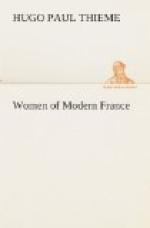According to reports, her beauty must have been of the ideal type of the time. All the portraits and images that Mme. du Barry has left of herself, in marble, engraving, or on canvas, show a mignonne perfection of body and face. Her hair was long, silky, of an ashen blonde, and was dressed like the hair of a child; her brows and lashes were brown, her nose small and finely cut. “It was a complexion which the century compared to a roseleaf fallen into milk. It was a neck which was like the neck of an antique statue....” In her were victorious youth, life, and a sort of the divinity of a Hebe; about her hovered that charm of intoxication, which made Voltaire cry out before one of her portraits: L’original etait fait pour les dieux! [The original was made for the gods!]
In her lofty position, Mme. du Barry sought to overcome the objections of the titled class, to quell jealousies and petty quarrels; she did not usurp any power and always endeavored not to trouble or embarrass anyone. After some time, she succeeded in winning the favor of some of the ladies, and, when her influence was fairly well established, she began to plan the overthrow of her enemy, De Choiseul, minister of Louis XV. She became the favorite of artists and musicians, and all Europe began to talk and write about this woman whom art had immortalized on canvas and who was then controlling the destinies of France. She succeeded, under the apprenticeship of her lover, the Duc d’Aiguillon, who was the outspoken enemy of De Choiseul, in accomplishing the fall of the minister and the fortune of her friend. This success required but a short time for its culmination, for in 1770 he was deprived of his office and was exiled to Chantilly.
Mme. du Barry was never an implacable enemy; she was too kind-hearted for that; thus, when her friend D’Aiguillon insisted on depriving De Choiseul of his fortune, she managed to procure for the latter a pension of sixty-thousand livres and one million ecus in cash, in spite of the opposition of D’Aiguillon. After the fall of that minister all the princes of the blood were glad to pay her homage. She became almost as powerful as Mme. de Pompadour, but her influence was not directed in the same channels.




